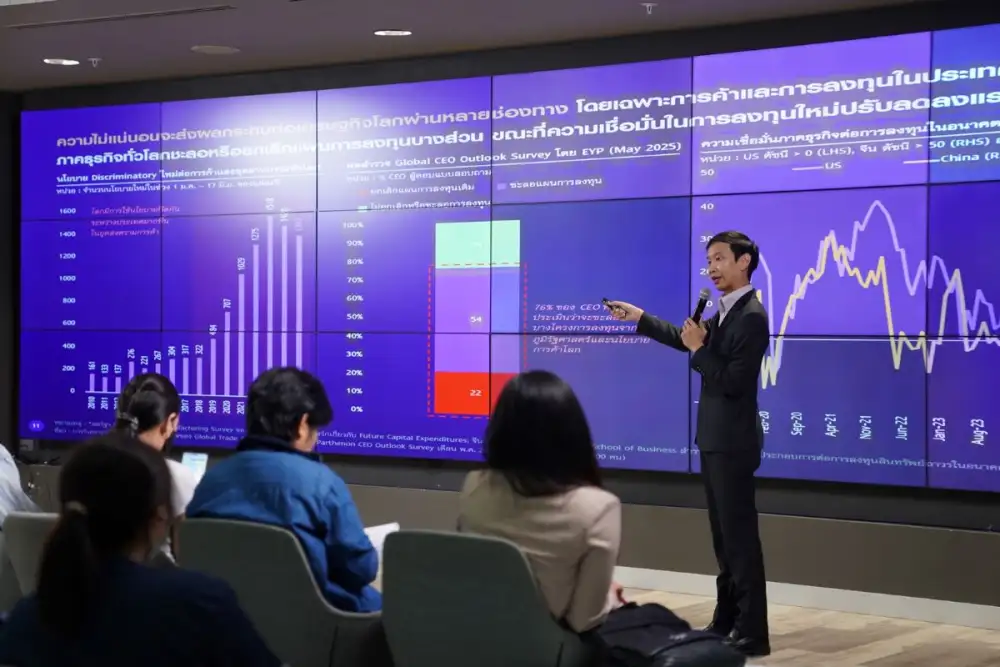
The global economy is expected to slow through next year, weighed down by the impacts of trade wars and elevated policy uncertainty.
SCB EIC projects that global economic growth will slow to 2.3% in 2025 and 2026, down from 2.8%in the previous year, primarily due to intensifying trade tensions and elevated economic uncertainty. The U.S. tariff hikes represent a supply-side shock that will weigh on the U.S. economy, leading to slower growth and accelerating inflation. In contrast, most other countries will face demand-side pressures, including weakening exports and easing inflation. Furthermore, heightened uncertainty surrounding U.S. trade policy and increased financial market volatility are undermining business and household confidence, resulting in postponed or reduced investment and consumption activities.

The impact on international trade and investment is expected to intensify and become more pronounced from the second half of 2025 onward, following front-loaded production and exports by several countries ahead of the imposition of U.S. import tariffs. SCB EIC anticipates that trade agreement negotiations between the U.S. and its trading partners may be prolonged and fail to conclude within the expected timeframe. In addition, ongoing legal processes within the U.S. concerning the president's authority to implement tariff policies will further contribute to elevated trade policy uncertainty during the second half of the year.
Moreover, the global economy continues to face heightened financial market volatility stemming from declining confidence in U.S. dollar-denominated assets and rising geopolitical risks. Confidence in the U.S. dollar and U.S. assets has weakened due to multiple factors, including policy uncertainty, a sharp increase in U.S. public debt leading to sovereign credit rating downgrades, and perceived attempts to interfere with the independence of the Federal Reserve. These developments have contributed to a depreciation of the U.S. dollar, while long-term U.S. Treasury yields have risen significantlyposing risks to the sustainability of U.S. fiscal policy going forward.
At the same time, heightened geopolitical risksparticularly the outbreak of conflict between Israel and Iranpose additional threats to the global economy. Although the immediate impact on oil prices may be limited due to ample excess supply, any escalation of the conflict that disrupts key supply sources in the Middle East would significantly increase global vulnerability and represent a major downside risk to the economic outlook.
Most major central banks are expected to adopt more accommodative monetary policies to support economic recovery, albeit at differing paces depending primarily on inflation trends. SCB EIC anticipates that the U.S. Federal Reserve (Fed) will initiate its first rate cut of 25 basis points toward the end of this year, followed by only two additional cuts of the same magnitude in 2026, due to persistent inflation risks stemming from tariff barriers and expansionary fiscal policies. Meanwhile, the People's Bank of China (PBOC) is expected to further lower its policy rate to 1%. As for the European Central Bank (ECB), its rate-cutting cycle is nearing completion, having already reduced rates by 100 basis points this year, with the likelihood of one additional 25-basis-point cut later this year amid easing inflationary pressures.
Thailand's economic growth is projected to remain below 2% through next year, weighed down by the global trade slowdown and persistent structural scars within the economy.
SCB EIC maintains its view that the Thai economy will grow at a subdued rate of 1.5% this year, with growth expected to slow further to 1.4% in 2026. This outlook reflects the effects of ongoing trade tensions, structural scars in the household and SME sectors, and growing constraints on fiscal policy. In the second half of this year, economic growth is projected to average below 1%, with a risk of entering a technical recession due to weakening exports and investment. Meanwhile, tourism is expected to provide less support than previously anticipated. The forecast for foreign tourist arrivals this year has been revised downward to 34.2 million, marking a contraction from the previous year, in line with the declining trend in Chinese visitors and more cautious spending behavior among tourists amid the global economic slowdown.
Private investment is likely to continue contracting, pressured by heightened trade policy uncertainty, weakening domestic and external purchasing power, and declining business confidence. These factors are prompting firms to delay investment decisions, despite the continued increase in investment promotion approvals by the Board of Investment (BOI).
Looking ahead, Thailand's key economic drivers are expected to lose momentum across nearly all dimensions, particularly private consumption, which is projected to decelerate significantly. A major contributing factor is the ongoing deleveraging process, as households continue to adjust from previously elevated debt levelsprompting more cautious spending behavior. In addition, consumption will face further headwinds from labor market and income vulnerabilities, sharply declining consumer confidence, and persistently tight financial conditions.
The government's revised economic stimulus plan, with a budget of THB 157 billion as a replacement for the digital wallet scheme, may offer more targeted support to the economy. However, its positive impact is expected to materialize more slowly and remain insufficient. SCB EIC estimates that the fiscal impulse from government spending will weaken in 2026, while public debt is projected to approach the 70% of GDP ceiling within the next one to two years. This trend could constrain the government's ability to implement further stimulus measures in the future, unless accompanied by fiscal reform.
Headline inflation remains in negative territory, reflecting continued declines in energy prices and subdued domestic purchasing power. Inflation is expected to remain negative in Q2 before gradually rising toward the end of the year. However, inflation is likely to stay below the target range through 2026, due to sluggish demand recovery and low growth in energy and agricultural prices. Geopolitical risks, particularly the ongoing conflict in the Middle East, remain a key factor to watch.
Further policy rate cuts remain warranted to help ease persistently tight financial conditions.
SCB EIC expects that the Monetary Policy Committee (MPC) may cut the policy rate two more times this year, bringing it down to 1.25%, in order to ease tightening financial conditions amid an economy growing well below its potential. Inflation has fallen below the lower bound of the monetary policy target, and credit quality continues to deteriorate. Financial conditions have remained persistently tight, as reflected by a real policy rate that remains above historical averages, continued contraction in credit, and a notable appreciation of the Thai baht against major trading partners' currenciesapproaching levels last seen in 1997.
Although the effectiveness of interest rate cuts may be limited under current conditionsgiven the structural challenges and elevated uncertainty facing the economythey can still play a supportive role in stabilizing economic activity, alleviating debt burdens for borrowers, and facilitating the deleveraging process among households and businesses. Concerns about excessive household borrowing following significant rate reductions are likely to be mitigated by financial institutions' cautious lending practices. Moreover, authorities retain the option to implement additional macroprudential measures should debt accumulation reach unsustainable levels.
Thai businesses are facing multiple challenges on several fronts, yet opportunities still remain.
Thailand's business sector continues to show signs of deceleration and faces rising uncertainty, driven by multiple risks that could adversely affect operations. Key concerns include uncertainty surrounding U.S. trade policy and the outcomes of trade negotiations, as well as the escalation of the Israel-Iran conflict, which could place renewed upward pressure on energy prices. In addition, the influx of Chinese imports is expected to intensify, posing challenges for both export-oriented industries and those focused on domestic consumption.
The disconnect between export growth and domestic export-oriented manufacturing activity may reflect the increasing influence of businesses with high import content and transshipment operationsfirms that route goods through Thailand for re-export to third countries by claiming Thai origin, without actual domestic production. These business models have gained a more prominent role within the Thai economy and constitute a key factor constraining the recovery of Thailand's manufacturing sector, particularly in industries such as electronics components and automotive. Similarly, sectors reliant on domestic purchasing power continue to face headwinds from persistent household vulnerabilities, weighing down the recovery prospects of core industries such as automotive and residential real estate. Furthermore, the tourism sector and related industries have also become a drag on overall business recovery.
Nevertheless, amid rising risks and uncertainty, certain subsegments of Thai businesses still hold growth potential by adapting and developing products and services that cater to high-potential consumer groups. These include businesses targeting emerging tourist segments, those offering uniquely differentiated products and services, and sectors aligned with global megatrendssuch as health and wellness and sustainabilitywhich continue to present strong growth opportunities even in times of crisis.